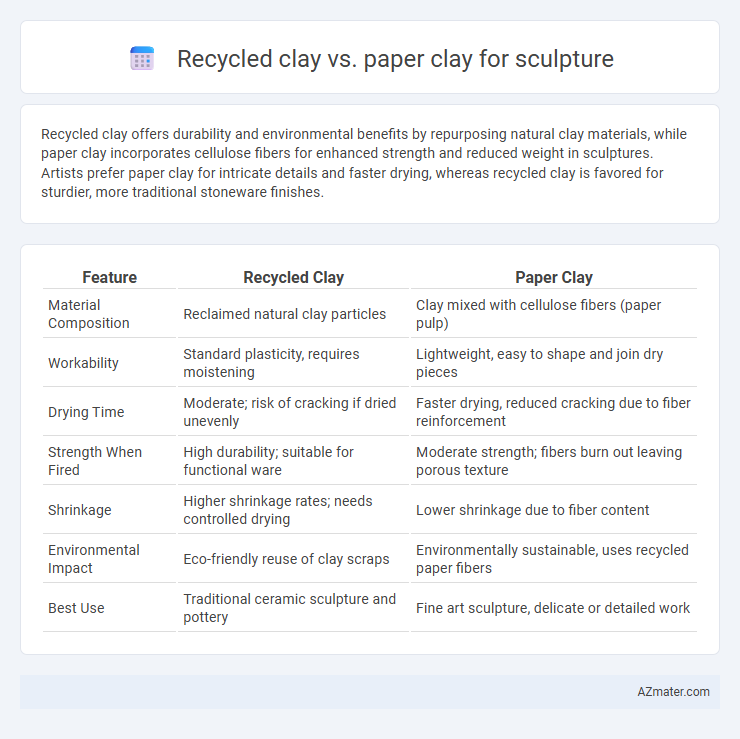Recycled clay offers durability and environmental benefits by repurposing natural clay materials, while paper clay incorporates cellulose fibers for enhanced strength and reduced weight in sculptures. Artists prefer paper clay for intricate details and faster drying, whereas recycled clay is favored for sturdier, more traditional stoneware finishes.
Table of Comparison
| Feature | Recycled Clay | Paper Clay |
|---|---|---|
| Material Composition | Reclaimed natural clay particles | Clay mixed with cellulose fibers (paper pulp) |
| Workability | Standard plasticity, requires moistening | Lightweight, easy to shape and join dry pieces |
| Drying Time | Moderate; risk of cracking if dried unevenly | Faster drying, reduced cracking due to fiber reinforcement |
| Strength When Fired | High durability; suitable for functional ware | Moderate strength; fibers burn out leaving porous texture |
| Shrinkage | Higher shrinkage rates; needs controlled drying | Lower shrinkage due to fiber content |
| Environmental Impact | Eco-friendly reuse of clay scraps | Environmentally sustainable, uses recycled paper fibers |
| Best Use | Traditional ceramic sculpture and pottery | Fine art sculpture, delicate or detailed work |
Introduction to Sustainable Sculpture Materials
Recycled clay and paper clay are innovative sustainable materials revolutionizing sculpture by minimizing environmental impact and promoting resource conservation. Recycled clay merges previously fired clay with fresh clay, reducing raw material usage and industrial waste, while paper clay combines natural fibers with clay to enhance strength and reduce shrinkage. Both materials offer eco-friendly alternatives for artists seeking durability and sustainability in their sculptural creations.
What is Recycled Clay?
Recycled clay is a type of ceramic material reclaimed from previously fired or unfired clay scraps, reshaped and reprocessed for new sculptural use, reducing waste and conserving resources. It maintains similar plasticity and firing properties to fresh clay but may require careful conditioning to remove impurities and achieve consistent texture. Compared to paper clay, which incorporates cellulose fibers for added strength and flexibility, recycled clay emphasizes sustainability by reusing existing ceramic material.
What is Paper Clay?
Paper clay is a specialized sculpting material made by mixing recycled paper fibers into traditional clay, enhancing its strength and flexibility when dried. Its increased tensile strength reduces cracking and allows for thinner, more delicate sculptural forms compared to standard recycled clay. Artists favor paper clay for its lightweight properties and the ease of joining pieces even when partially dry, enabling complex and detailed sculptures.
Material Composition: Recycled Clay vs Paper Clay
Recycled clay is primarily composed of previously used natural clay mixed with water, retaining its original mineral structure but requiring careful processing to remove impurities and restore plasticity. Paper clay integrates cellulose fibers, such as paper pulp, into natural clay, enhancing its tensile strength, reducing shrinkage, and improving its ability to dry without cracking. The addition of organic fibers in paper clay creates a lighter, more pliable material ideal for detailed sculptural work compared to the denser, more traditional texture of recycled clay.
Workability and Sculpting Techniques
Recycled clay offers robust plasticity and smooth texture, making it ideal for wheel-throwing and hand-building techniques but may require thorough wedging to remove air bubbles. Paper clay, infused with cellulose fibers, enhances tensile strength and drying flexibility, allowing for thinner walls and easier attachment of delicate parts without cracking. Sculptors often prefer paper clay for mixed-media applications and fine details, while recycled clay suits traditional sculpting methods demanding dense, sturdy forms.
Drying Time and Shrinkage Differences
Recycled clay typically experiences longer drying times due to its higher moisture retention and denser particle composition, which reduces the risk of cracking but demands patience in the sculpting process. Paper clay incorporates cellulose fibers that accelerate drying by improving airflow and reducing overall moisture content, resulting in faster drying times and less shrinkage compared to traditional recycled clay. Shrinkage in recycled clay can reach up to 12%, whereas paper clay maintains shrinkage rates as low as 5%, enhancing dimensional stability and reducing post-firing distortion.
Strength and Durability Comparison
Recycled clay offers moderate strength suited for small to medium sculptures, but its durability can be compromised by impurities and inconsistent composition. Paper clay incorporates cellulose fibers that enhance tensile strength and reduce cracking, resulting in superior durability and resilience for sculptural applications. The fiber reinforcement in paper clay provides better structural integrity, making it ideal for fine details and larger, more complex forms compared to recycled clay.
Environmental Impact and Sustainability
Recycled clay reduces waste by repurposing leftover ceramic material, lowering the demand for raw clay extraction and conserving natural resources. Paper clay incorporates recycled paper fibers, enhancing strength while using renewable materials that decompose more easily than traditional clays. Both options support sustainable sculpture practices by minimizing environmental footprints, with paper clay offering added benefits in energy savings during firing due to its lighter composition.
Cost-Effectiveness in Art Studios
Recycled clay offers a highly cost-effective option for art studios by significantly reducing raw material expenses and minimizing waste, making it ideal for large-scale or frequent sculpting projects. Paper clay, while slightly more expensive due to its fiber content and improved workability, enhances durability and drying flexibility, potentially lowering long-term costs associated with breakage and rework. Studios prioritizing budget efficiency benefit from recycled clay's affordability, whereas those seeking balance between cost and enhanced material properties might favor paper clay.
Choosing the Right Clay for Your Sculptural Needs
Recycled clay offers eco-friendly benefits and natural texture ideal for sustainable sculpture projects, while paper clay provides enhanced workability and reduced cracking due to its fiber content, making it perfect for fine detail and complex forms. Consider recycled clay for durability and environmental impact, whereas paper clay excels in lightweight, intricate sculptures requiring a smooth finish. Evaluating the sculpture's size, detail level, drying time, and final use ensures selecting the right clay enhances artistic outcomes and structural integrity.

Infographic: Recycled clay vs Paper clay for Sculpture
 azmater.com
azmater.com